The Waxing Crescent Moon Craves Attention, Mars at Maximum Size, and Holiday Season Evening Bright Lights!
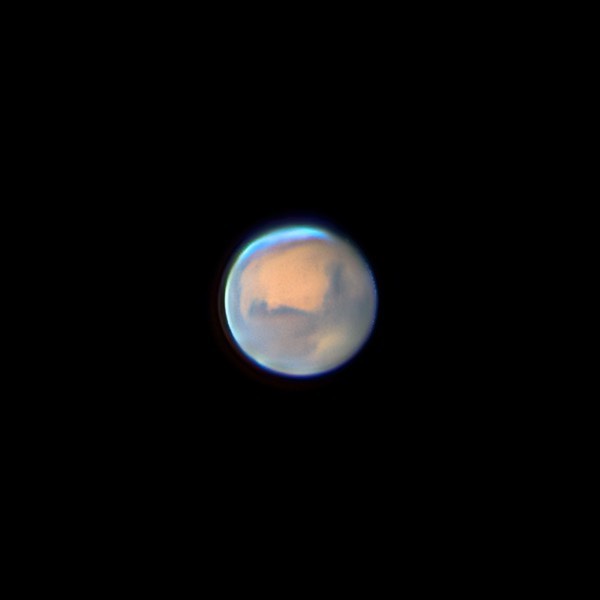
This terrific image of Mars was taken by Andrea Girones of Ottawa on November 23, 2022 at 11:35 pm EST. The large bright area at upper left is named Aeria. the dark region below that is Sinus Sabaeus, and the dark feature to the right is Mare Acidalum. Dark features on Mars tend to be exposed basaltic rock. The bluish areas are clouds and ice! Using an astro-camera on an 11″ SCT telescope, she took monochrome images through several colour filters and combined them.
Hello, End-of-November, Stargazers!
Here are your Astronomy Skylights for the week of November 27th, 2022 by Chris Vaughan. Feel free to pass this along to your friends and send me your comments, questions, and suggested topics. You can also follow me on Twitter as @astrogeoguy! Unless otherwise noted, all times are expressed in Eastern Time. To subscribe to these emails please click this MailChimp link.
If you’d like me to bring my Digital Starlab portable inflatable planetarium to your school or other daytime or evening event, or deliver a session online, contact me through AstroGeo.ca, and we’ll tour the Universe, or the Earth’s interior, together! My terrific book with John A. Read entitled 110 Things to See With a Telescope is a guide to viewing the deep sky objects in the Messier List – for both beginners and seasoned astronomers. DM me to order a signed copy!
The moon will draw your deserved attention in evening this week as it waxes through first quarter for a second time in November. Towards the end of the week all of the planets will be visible in evening skies – but Mars at closest approach to Earth is the big show. Finally, keep an eye out for the occasional shooting star as you appreciate the brightest of the fixed ones! Read on for your Skylights!
Meteor Shower Update
Meteor season continues! The terrific Geminids meteor shower began on November 19. The shower will ramp up to as many as 150 meteors per hour on its peak night of December 13-14. But a very bright moon will spoil the show a bit this year. During evenings this week, true Geminids will appear to be streaking away from the northeastern horizon, where the constellation of Gemini (the Twins) will be ascending.
The Moon
This will be the best week of the lunar month to enjoy views of our natural satellite in the evening. That’s because the terrain alongside the moon’s curved terminator will be illuminated by the rising sun. Its nearly horizontal rays of sunlight will cast shadows to the lunar west of every bump, hill, crater rim, and mountain peak – making an impressive sight in a backyard telescope or through binoculars. As the moon slides eastward away from the sun, it will increase in illuminated phase and set about 80 minutes later each evening, causing new parts of the moon to be highlighted each night. With the early sunsets at this time of year, even the youngest astronomers can enjoy the show!
Tonight (Sunday) the gorgeous crescent moon will shine in the southwestern sky after dusk. The faint stars of Capricornus (the Sea-Goat) and the yellowish dot of Saturn will be positioned to the moon’s upper left (or celestial northeast). As the sky darkens during evening on Monday, Saturn will be positioned a generous palm’s width above (or 7 degrees to the northeast of) the moon. By the time the moon sets in the west around 9:45 pm local time, its orbital motion will have carried it a bit closer to Saturn.
On Tuesday evening, the moon will shine farther to Saturn’s east. From Tuesday to Thursday, the moon will cross through the stars of Aquarius (the Water-Bearer). When a major lunar phase occurs very early in a calendar month, it can repeat at the end of that month. For the second time in November, the moon will complete the first quarter of its journey around Earth on Wednesday, November 30 at 9:36 am EST, 6:36 am PST, and 14:36 Greenwich Mean Time. When the moon rises in the Americas during late afternoon, it will be shining in below and between the bright planets Jupiter and Saturn. Telescope owners can seek out the magnitude 9.2 speck of the asteroid Juno sitting just a fraction of the moon’s diameter to the moon’s lower left (or celestial south).
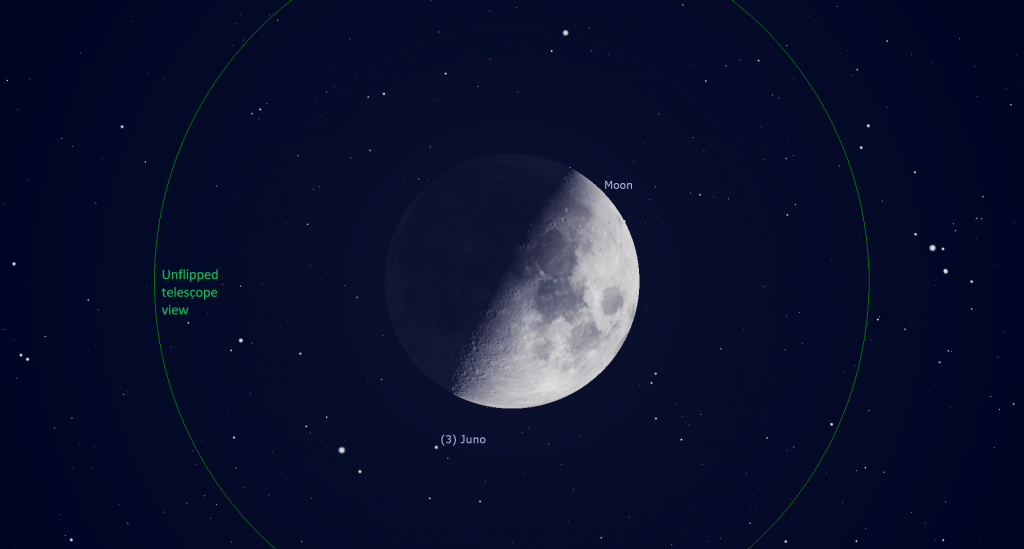
In the southeastern afternoon sky on Thursday, the waxing gibbous moon will be positioned several finger widths to the lower right (or celestial south) of the bright, magnitude -2.6 planet Jupiter. The duo will be close enough to share the view in binoculars, allowing observers to glimpse the giant planet’s bright speck in the daytime. The pair will remain near one another in evening and set together in the west after 1 am local time. By then the diurnal rotation of the sky will shift Jupiter to the moon’s left. Much fainter, magnitude 7.9 Neptune will be positioned a palm’s width to Jupiter’s right (or celestial WSW), but the bright moonlight will make seeing the distant blue planet more difficult. On moonless nights, Neptune is visible through good binoculars and backyard telescopes.
The moon will use the end of the week to swim along the crooked border between Cetus (the Whale) and Pisces (the Fishes). On Sunday night, the bright moon will be positioned less than a fist’s diameter to the right (or approximately 8 degrees to the celestial WSW) of the magnitude 5.6 planet Uranus. The moon’s eastward orbital motion, plus the diurnal rotation of the sky, will tuck Luna closer below Uranus during the night. Observers in westerly time zones of North America will see the pair closest together before dawn. Hours later, observers in northeastern Africa, Europe (except Iceland), part of the Middle East, Russia, and northern Japan can see the moon pass in front of (or occult) Uranus on Monday around 17:00 GMT. Watch for bright red Mars and the little Pleiades star cluster, also designated Messier 45, positioned to their left (celestial east).
The Planets
This week will include the first of two major Mars events! Tonight (Sunday) the red planet will rise over the northeastern horizon at about 5:15 pm local time. Once it clears the rooftops an hour later, its bright, magnitude -1.78 reddish dot can’t help but catch your eye. Mars will be shining between the horn stars of Taurus (the Bull), with the bright reddish star Aldebaran, which marks the bull’s eye, sparkling to Mars’ right (celestial WSW). The planet will climb to a very high perch, due south, around 1 am local time. Early risers can spot Mars above the western horizon before sunrise.
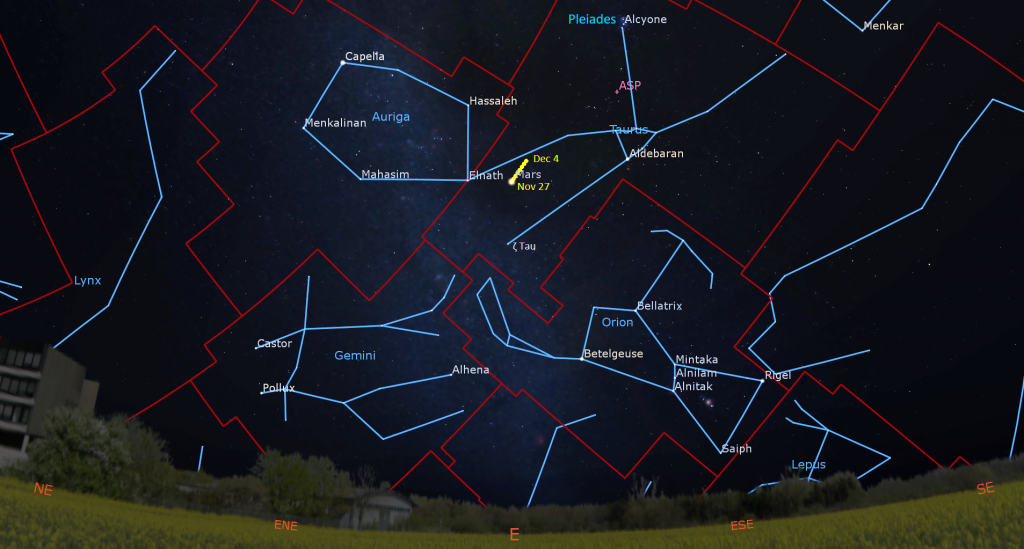
Mars has been growing in apparent size (in your telescope’s eyepiece) and increasing its visual brightness in the sky because Earth is passing the red planet on the inside track around the sun. Earth’s faster motion makes Mars seem to slide westward through the stars. That retrograde loop will last into mid-January. This week, you’ll notice that Mars is already to the right (west) of the bull’s horns – higher than medium-bright Zeta Tauri (the lower horn tip star) and lower than Elnath or Beta Tauri (the higher horn tip star). Over the next month, Mars will steadily slide towards the bright Pleiades star cluster, which is the prominent little clump of stars above Aldebaran.
Mars will be closest to Earth in late evening on Wednesday, November 30 in the Americas. At 9 pm, EST, the planet will be 81.449 million km, or 4.53 light-minutes away from us. In a telescope, the planet will exhibit a maximum apparent disk size of 17.2 arc-seconds (about 40% of the apparent size of Jupiter’s disk), revealing the greatest amount of surface details. Don’t fret if it’s cloudy on Wednesday – Mars will actually show the same sized disk from Monday through Sunday. Mars will be slightly farther from Earth at its next opposition in January, 2025. It won’t be this close to Earth until June, 2033! The August 15, 2050 Mars opposition will be closest of all – only 56 million km, yielding a 25 arc-seconds wide disk!

Mars will continue to visibly brighten in the sky until it sits precisely opposite from the sun on December 7-8. The difference in the closest and brightest dates occurs because the distance between the elliptical orbits of Earth and Mars is increasing at this time of the year.
Mars is a terrific object to view in a backyard telescope when it gets this close to us. Viewed in a backyard telescope this week, Mars will show a waxing, 99%-illuminated disk. If the air is steady you might see some dark markings on the planet and the white patch of its northern polar cap. Mars takes about 20 minutes longer than Earth to rotate once fully on its axis. So viewing the planet at the same time on subsequent nights will show roughly the same view of it, but with the surface markings shifted by about 5°. If you have coloured filters for your telescope, see if the blue, orange, or red one improves the view. If you find Mars is too bright, use a moon filter on it.
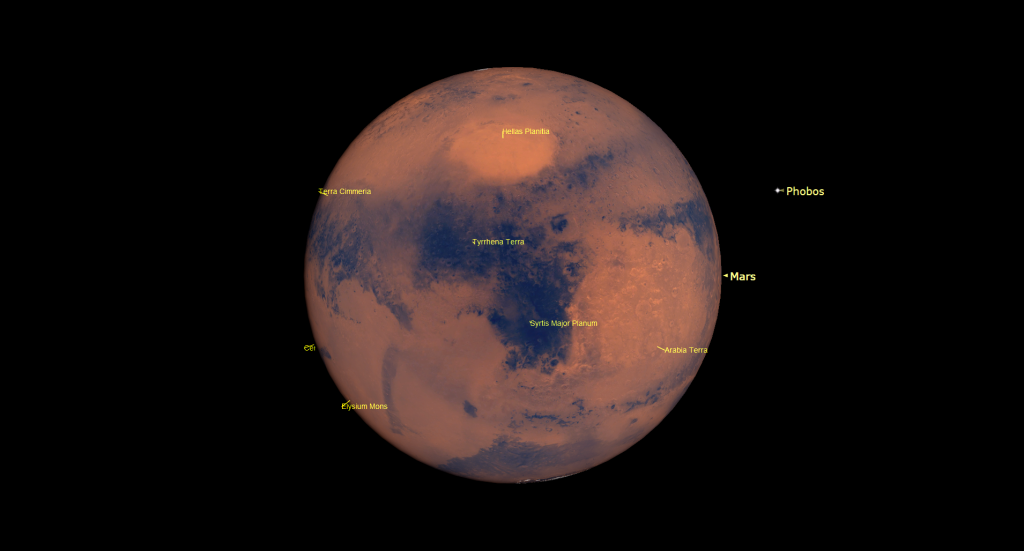
From Friday until next Monday, Mars will travel just a thumb’s width to the celestial north of a large open star cluster named NGC 1746. That’s close enough for them to share the eyepiece in a backyard telescope at low magnification. On Friday evening, Mars will shine to the cluster’s upper left. By Sunday night, Mars will migrate closely above NGC 1746’s smattering of stars, which are scattered over an area larger than a full moon. Your telescope will probably flip and/or mirror that arrangement.
Let’s give the rest of the planets some love. Mercury and Venus will be tucked above the southwestern horizon immediately after sunset, but only observers in the tropics will be able to spot them safely once the sun has completely disappeared. The two inner planets will become easier to see by the end of this week. Once the sky has completely darkened, by 6 pm local time at mid-northern latitudes, all the rest of the main planets will be above the horizon. Mars, Jupiter, and Saturn will form a 120 degrees long arc across the sky – tracing out the plane of our solar system. Uranus, Neptune, and a couple of major asteroids will lurk between those bright planets.

With the sun now setting at 4:43 pm, the yellowish dot of Saturn will become visible in the southern sky by about 5:30 pm local time. Enjoy your views of it as soon as you can find it in your telescope because it will look less crisp as it drops lower after dinner. Saturn will be shining just to the right (celestial west) of the medium-bright tail stars of Capricornus (the Sea-Goat), Deneb Algedi on the left (celestial east) and Nashira on the right (celestial west). In the coming months, you’ll be able to use binoculars or your sharp eyesight to see that Saturn’s easterly prograde motion is shifting the planet toward them. I plotted Saturn’s long-term path here.
On a night with steady air, good, 10×42 binoculars (and larger) should present Saturn and its rings as a tiny oval. On those nights, even a small telescope can show Saturn’s subtly banded globe encircled by its glorious rings, which are sufficiently edge-on to Earth to allow Saturn’s southern polar region to extend well below the ring plane. (Your telescope might flip the planet.) See if you can make out the Cassini Division, a narrow, dark gap that separates Saturn’s main inner ring (named B) from its bright outer ring (named A). Any telescope should show that a segment of Saturn’s rings adjacent to the eastern limb of the planet is in shadow.
A small telescope can also pick up several of Saturn’s moons – especially its largest, brightest moon, Titan! From here on Earth, Saturn’s axial tilt of 26.7° lets us see the top of its ring plane, and allows its brighter moons to array themselves all around the planet. (In contrast with Saturn, Jupiter’s axis is only tilted by 3°, so Jupiter’s moons are arranged in a line running through that planet’s equator.)
Titan never wanders more than five times the width of Saturn’s rings from the planet. The much fainter moon named Iapetus can stray up to twelve times the rings’ width during its 80-day orbit of Saturn. The next brightest moons Rhea, Dione, Tethys, Enceladus, and Mimas all stay within one ring-width of Saturn. During evening this week, Titan will migrate counter-clockwise around Saturn, moving from the left (or celestial east) of Saturn tonight (Sunday) to the lower right (or celestial west) of Saturn next Sunday. (Remember that your telescope might flip that view around.) How many of the moons can you see in your telescope?
The extremely bright, magnitude -2.6 planet Jupiter will become visible in the southeast shortly after sunset, at about 5 pm local time. Nothing else will be close to matching its brilliance until half as bright Mars appears. Jupiter will look best in a telescope when it climbs highest (or culminates) due south around 7:30 pm local time, and then it will set in the west at about 1:30 am local time.
Your binoculars should be able to show you Jupiter as a noticeable disk flanked by its line of four Galilean moons named Io, Europa, Ganymede, and Callisto. Those moons complete orbits of the planet every 1.7, 3.6, 7.2, and 16.7 days, respectively. If you see fewer than four moons, then one or more of them is crossing in front of or behind Jupiter, or hiding in Jupiter’s dark shadow – or two of the moons are very close together or occulting one another. Their arrangement varies each night.
Use your binoculars to spy a pentagon-shaped ring of low-brightness stars shining about a fist’s diameter to the upper right of Jupiter. They make up the western head of Pisces (the Fishes). Above those stars, the Great Square of Pegasus (the Flying Horse) will be visible, even with your unaided eyes. It’s located about 2.5 fist diameters above Jupiter.
Even a small, but decent quality telescope can show you Jupiter’s dark belts and light bands, which are aligned parallel to its equator. With a better grade of optics, Jupiter’s Great Red Spot, a cyclonic storm that has raged for hundreds of years, becomes visible for several hours when it crosses the planet every 2nd or 3rd night. For observers in the Americas, that GRS will cross Jupiter’s disk in early evening on Sunday, Wednesday, and Friday, and late on Tuesday, Thursday, and Sunday evening. If you have any coloured filters or nebula filters for your telescope, try enhancing the GRS with them.
The round, black shadows of Jupiter’s Galilean moons are visible through a good backyard telescope when they cross the planet’s disk. For observers in the America’s, Io’s shadow will cross Jupiter’s equator on Thursday night between 9:43 pm and 11:50 pm EST. On Sunday evening, December 4 observers in western North America can watch the small shadow of Europa cross the southern hemisphere of the planet from 5:15 pm to 7:35 pm EST. Don’t forget to adjust these quoted times into your own time zone.

In mid-evening, magnitude 7.9 Neptune is located a palm’s width to the lower right (or 6° to the celestial west-southwest) of Jupiter. On Saturday evening, December 3 in the Americas, Neptune will complete a retrograde loop that has been carrying it slowly westward through the stars of northeastern Aquarius (the Water-Bearer) since late June. After pausing in its motion tonight, Neptune will return to its regular eastward motion. Neptune’s apparent disk size is 2.3 arc-seconds (20 times smaller than Jupiter’s). Try to view Neptune while it is highest, around 7 pm. Neptune is binoculars-close to several groups of medium-bright stars. I posted a finder chart for Neptune here. The large asteroids designated (4) Vesta and (3) Juno are currently in Aquarius (the Water-Bearer) between Jupiter and Saturn, too.
The distant blue-green planet Uranus is located about midway between Mars and Jupiter, and about 1.4 fist widths to the upper right (or 14° to the celestial west-southwest) of the Pleiades star cluster. Closer guideposts to Uranus are several medium-bright stars, including Botein (or Delta Arietis), Al Butain II (or Rho Arietis), and Sigma Arietis, which will appear several finger widths from the planet. Those stars mark the feet of the Aries (the Ram). Magnitude 5.6 Uranus will be high enough for telescope-viewing, in the lower part of the eastern sky, before 7 pm local time this week. It will climb to its highest point in the southern sky around 10:30 pm local time.
Holiday Season Bright Lights
The brightest constellations of the year have returned to the evening sky – with many of them containing two or more very bright stars. Meanwhile, quite a few of the brightest summer stars are still around because the earlier sunsets are keeping them in view, even as they shift towards the sun. Some call this “the Summer Triangle effect”. (Conversely, every spring the later sunsets shorten our viewing time for the spring constellations – and the galaxies that they host.)
Bright stars remain easy to see on moonlit nights, even under mildly light-polluted skies. Once Sirius rises over the southeastern horizon just before 10 pm local time, 16 of the 30 brightest stars in the entire night sky will be visible to observers at mid-northern latitudes worldwide. Let’s tour the brightest ones. I’ve put their brightness rankings (not counting the sun) in parentheses.
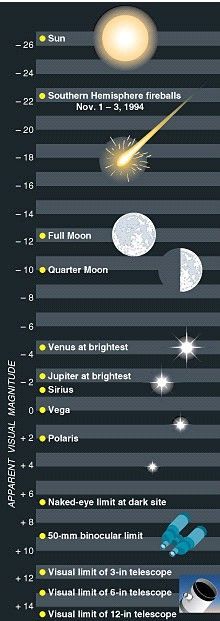
As the sky is fully darkening this week, look high in the western sky for the three bright, white stars of the Summer Triangle. Despite their name, those stars will continue to be visible until mid-January! During mid-evening, the very bright, magnitude 0.0 star Vega (5th) in Lyra (the Harp) will shine about halfway up the northwestern sky. Altair (12th) in Aquila (the Eagle) will be slightly lower and off to Vega’s left (or celestial south) – preparing to set at about the same time that Sirius rises. More than two fist diameters above and between Vega and Altair you’ll find Deneb (19th), Cygnus the Swan’s brightest star.
Vega is the reference point for the visual brightness scale. Magnitude values greater than 0.0 are fainter than Vega. Objects with negative magnitude values shine brighter than Vega. A single integer jump in value (either up or down) translates to a 2.5 times difference in visual brightness.
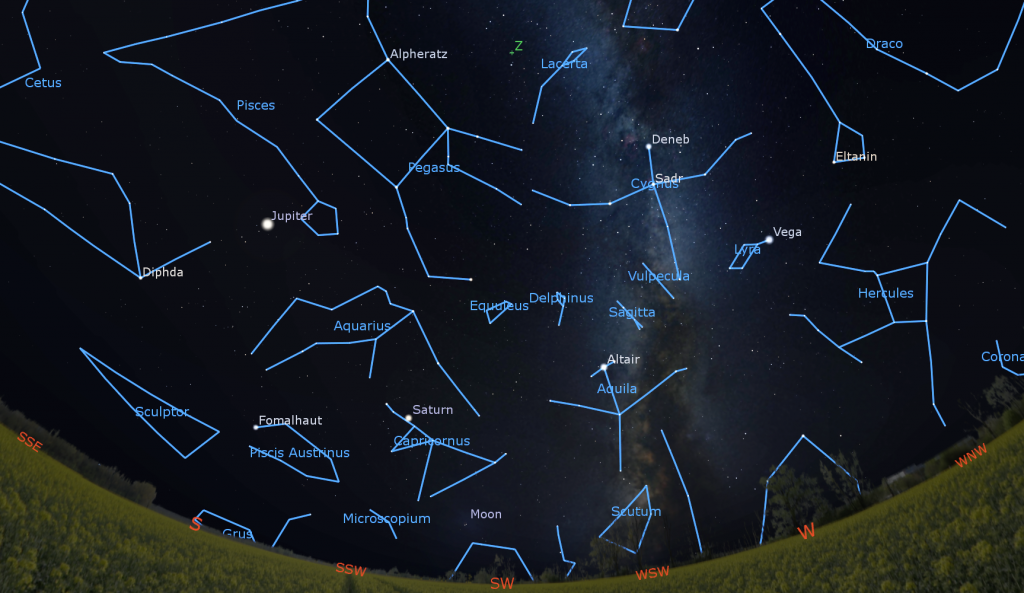
Turning to face south, mid-northern latitude observers with a low southern horizon should be able to see Fomalhaut (18th) in Piscis Austrinus (the Southern Fish). Big telescopes have been able to take pictures of a dusty proto-planetary disk that encircles Fomalhaut. Fomalhaut will be highest when it sits due south around 7 pm local time. People living at more southerly latitudes get to see Fomalhaut twinkling higher in their sky. This year, 32 times brighter Jupiter and 1.4 times brighter Saturn will shine to Fomalhaut’s upper left and right, respectively.
The rest of the brightest stars are in the eastern sky after mid-evening. Yellowish Capella (6th), in Auriga (the Charioteer) is the brightest and highest of the eastern sky’s bright lights. Although it is circumpolar (i.e., it never sets) for mid-latitudes, it doesn’t tend to climb higher than landscape obstacles until after 6 pm local time. Reddish Aldebaran (14th), which marks Taurus the bull’s southern eye, is located three fist diameters to the lower right (or 30 degrees to the celestial south) of Capella. It’s rising by 6 pm local time this week. Magnitude 1.65 Elnath (27th) is the star at the opposite side of Auriga’s ring from Capella and also serves as Taurus’ upper horn tip. Mars will shine between them this year.
The next very bright star to rise, at about 7:30 pm local time, will be orange-red Betelgeuse (normally 10th). This red giant marks the eastern shoulder, or armpit, of Orion (the Hunter). During the winter of 2019-2020 Betelgeuse dimmed dramatically, lowering its ranking for several months. Orion’s right-hand (western) shoulder, the star Bellatrix (26th), will rise half an hour before Betelgeuse.
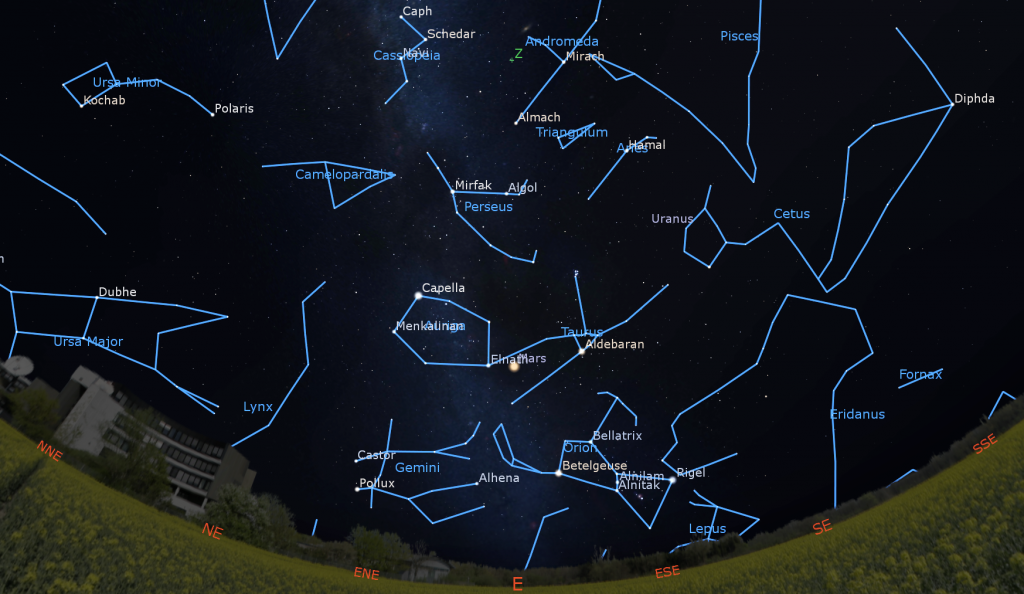
Castor (24th), which marks the head of the western (and higher) sibling of Gemini (the Twins) will appear around the same time as Orion’s shoulders, but is located several fist diameters off to their left. Castor is positioned about three fist diameters below (or 30 degrees to the celestial southeast of) Capella. The star sitting about four finger widths below Castor is Pollux (17th). To help you remember which is which, note that Castor comes first in an alphabetical list and also rises before Pollux. Despite them being “twins”, Pollux is somewhat brighter and warmer in colour than Castor. Castor is a fantastic multiple star when viewed in any backyard telescope.
Around the same time that Pollux rises, blue-white Rigel (7th), which marks the western foot of Orion, will appear over the east-southeastern horizon. Then we have to wait 90 minutes for the next bright star to appear – Procyon (8th), in Canis Minor (the Little Dog). It’s below and between Gemini and Orion. While you wait, take a few minutes to appreciate the three stars in Orion’s Belt. From bottom to top (or celestial east to west), they are Alnitak (33rd), Alnilam (29th), and Mintaka (67th). Alnilam is 2000 light-years away from us, compared to the other two, which are half as far away.
Our last bright stars to rise are part of Canis Major (the Big Dog). The “Dog Star” Sirius (1st) will be hard to miss once it rises toward 10 pm local time. The star will climb to its highest point, about a third of the way up the southern sky, at 2:30 am local time. If you are walking through your darkened house in the middle of the night, Sirius might catch your eye out a south-facing window because it never climbs very high. Sirius’ brightness and low position in the sky combine to produce spectacular flashes of colour as it twinkles. Finally, after 11:30 pm, the stars Adhara (22nd) and Wezen (36th) will appear below Sirius. They mark the dog’s rear leg and rump, respectively, and gives this little constellation an over weighted three bright stars!
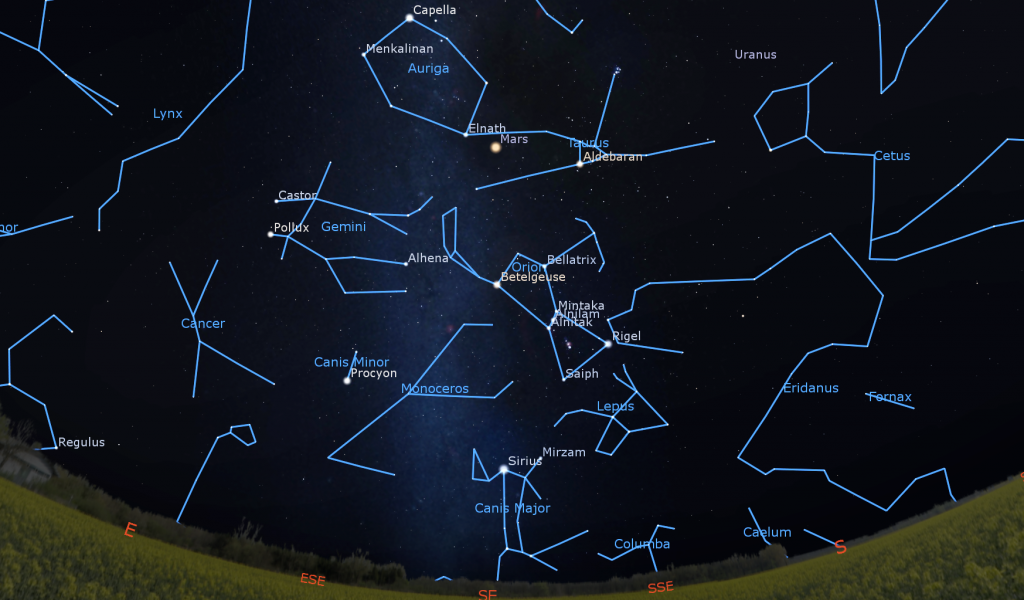
Stars appear brighter for two primary reasons. They can be inherently more luminous (i.e., emitting more visible light) and/or they can be closer to us. Two of the stars noted above, Sirius and Procyon, are only about 10 light-years away from our sun. Vega, Altair, Pollux, and Fomalhaut are less than a few dozen light-years away. Betelgeuse is 640 light-years away. Amazingly, Deneb is a whopping 2,600 light-years away! It must be producing a prodigious amount of visible light to appear so bright from such a distance!
With each week that rolls by, the stars will rise about half an hour earlier. Enjoy!
Admiring Andromeda
If you missed last week’s deep tour of Andromeda (the Princess), I posted it here.
Public Astro-Themed Events
Every Monday evening, York University’s Allan I. Carswell Observatory runs an online star party – broadcasting views from four telescopes/cameras, answering viewer questions, and taking requests! Details are here. They host in-person viewing on the first clear Wednesday night each month. On Wednesdays they stream views online via the observatory YouTube channel. Details are here.
Taking advantage of the crescent moon in the sky this week, the RASC Toronto Centre astronomers will hold their free monthly City Sky Star Party in Bayview Village Park (steps from the Bayview subway station), starting after dusk on the first clear weeknight this week (Mon to Thu only). Check here for details, and check the banner on their website home page or Facebook page for the GO or NO-GO decision around 5 pm each day.
My free, family-friendly Insider’s Guide to the Galaxy webcast with Samantha Jewett of RASC National returns on Tuesday, December 6 at 3:30 pm EST. This time, the holidays are upon us, so we’ll gather a few friends to chat about the astronomy-related items on our wish lists – books, gear, apparel, and more. We’ll touch on the Dec 7 Mars opposition and lunar occultation, and we’ll highlight the next batch of RASC’s Finest NGC objects. You can find more details and the schedule of future sessions here.
Keep looking up, and enjoy the sky when you do. I love questions and requests. Send me some!